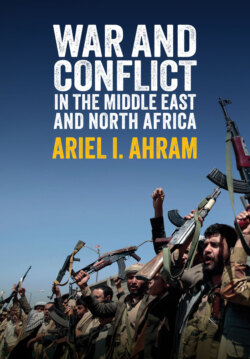Читать книгу War and Conflict in the Middle East and North Africa - Ariel I. Ahram - Страница 12
Notes
Оглавление1 1. Joshua S. Goldstein, Winning the War on War: The Decline of Armed Conflict Worldwide (New York: Penguin, 2012); Nils Petter Gleditsch et al., “The Forum: The Decline of War,” International Studies Review 15, no. 3 (2013): 396–419.
2 2. Stockholm International Peace Research Institute, SIPRI Yearbook 2017 (New York: Oxford University Press, 2017), 3.
3 3. Robert Malley, “The Unwanted Wars: Why the Middle East Is More Combustible Than Ever,” Foreign Affairs, November 1, 2019.
4 4. Miguel A. Centeno and Elaine Enriquez, War and Society (Cambridge: Polity, 2016), 175. See also Wim A. Smit, “Military Technologies and Politics,” in The Oxford Handbook of Contextual Political Analysis, edited by Charles Tilly and Robert E. Goodin (New York: Oxford University Press, 2009).
5 5. Paul Collier, Breaking the Conflict Trap: Civil War and Development Policy (Washington, DC: World Bank Publications, 2003), 13.
6 6. Charles Tilly, Coercion, Capital, and European States, AD 990–1990 (Cambridge, Mass.: Basil Blackwell, 1990); Joel S. Migdal, Strong Societies and Weak States: State–Society Relations and State Capabilities in the Third World (Princeton, NJ: Princeton University Press, 1988); Kalevi J. Holsti, “War, Peace, and the State of the State,” International Political Science Review 16, no. 4 (1995): 319–39; Dan Slater, “Violent Origins of Authoritarian Variation: Rebellion Type and Regime Type in Cold War Southeast Asia,” Government and Opposition 55, no. 1 (2020): 21–40.
7 7. Alexander Bellamy, World Peace (and How We Can Achieve It) (New York: Oxford University Press, 2019), 126.
8 8. Michael Mann, The Sources of Social Power, Volume 1: A History of Power from the Beginning to AD 1760 (New York: Cambridge University Press, 1986), 11.
9 9. Douglass C. North, John Joseph Wallis, and Barry R. Weingast, Violence and Social Orders: A Conceptual Framework for Interpreting Recorded Human History (New York: Cambridge University Press, 2009).
10 10. Edward W. Said, Orientalism (New York: Vintage, 1979), 83.
11 11. Abbas Amanat, Is There a Middle East? The Evolution of a Geopolitical Concept (Stanford, Calif.: Stanford University Press, 2012).
12 12. Fred Halliday, The Middle East in International Relations: Power, Politics and Ideology (New York: Cambridge University Press, 2005), 81.
13 13. Nikki R. Keddie, “Is There a Middle East?,” International Journal of Middle East Studies 4, no. 3 (1973): 255–71 (258).
14 14. Yaniv Voller, “From Periphery to the Moderates: Israeli Identity and Foreign Policy in the Middle East,” Political Science Quarterly 130, no. 3 (2015): 505–36; Kamal S. Salibi, “The Lebanese Identity,” Journal of Contemporary History 6, no. 1 (1971): 76–86.
15 15. Martin W. Lewis and Kären E. Wigen, eds., The Myth of Continents: A Critique of Metageography (Berkeley: University of California Press, 1997); Ariel I. Ahram, Patrick Köllner, and Rudra Sil, eds., Comparative Area Studies: Methodological Rationales and Cross-Regional Applications (New York: Oxford University Press, 2018).
16 16. For one example, see Paul Salem and Ross Harrison, eds., Escaping the Conflict Trap: Toward Ending Civil Wars in the Middle East (Washington, DC: Middle East Institute, 2019).
17 17. One recent exception is Anders Jägerskog, Michael Schulz, and Ashok Swain, eds., Routledge Handbook on Middle East Security (London: Routledge, 2019).
18 18. Hazem Adam Ghobarah, Paul Huth, and Bruce Russett, “The Post-War Public Health Effects of Civil Conflict,” Social Science & Medicine 59, no. 4 (2004): 869–84; Christopher J. L. Murray et al., “Armed Conflict as a Public Health Problem,” BMJ 324, no. 7333 (2002): 346–9; Michael Palmer et al., “Long-Lasting Consequences of War on Disability,” Journal of Peace Research 56, no. 6 (2019): 860–75.
19 19. Michael N. Barnett, Confronting the Costs of War: Military Power, State, and Society in Egypt and Israel (Princeton, NJ: Princeton University Press, 2012); Thierry Gongora, “War Making and State Power in the Contemporary Middle East,” International Journal of Middle East Studies 29, no. 3 (1997): 323–40.
20 20. Steven Heydemann, “Introduction,” in War, Institutions, and Social Change in the Middle East, edited by Steven Heydemann (Berkeley: University of California Press, 2000), 1.
21 21. Lingyu Lu and Cameron G. Thies, “War, Rivalry, and State Building in the Middle East,” Political Research Quarterly 66, no. 2 (2013): 239–53; Mehran Kamrava, Inside the Arab State (New York: Oxford University Press, 2018); Daniel Neep, “War, State Formation, and Culture,” International Journal of Middle East Studies 45, no. 4 (2013): 795–7; Rolf Schwarz, “Does War Make States? Rentierism and the Formation of States in the Middle East,” European Political Science Review 3, no. 3 (2011): 419–43.
22 22. Bent Flyvbjerg, Making Social Science Matter: Why Social Inquiry Fails and How It Can Succeed Again (New York: Cambridge University Press, 2001); Karl Spracklen, Making the Moral Case for Social Sciences: Stemming the Tide (New York: Springer, 2015).
